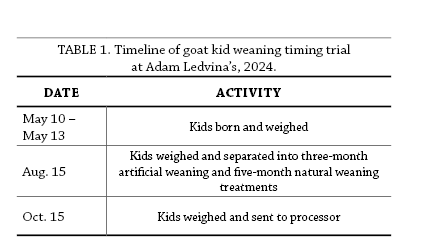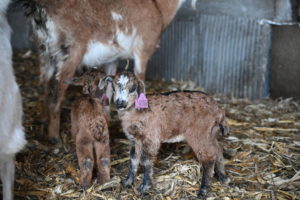This research is supported by The Builders Initiative.
In a Nutshell
- Goat farmers often wonder when they should wean kids.
- Earlier weaning times may allow farmers to send animals to market sooner or produce more profit from milking or contract grazing does. However, weaning too early could result in smaller animals or even pose health risks for the kids.
- Adam Ledvina raises Kiko goats on pasture. He tested whether weaning goat kids at three months vs. leaving them with their mothers (dams) until processing at five months had any effects on kid weights or average daily gains.
Key Findings
- There were no significant differences in weights or average daily gains of five-month-old twin kids that were either artificially weaned at three months or left with their dams for natural weaning until they were five months old.
- In the future, Ledvina plans to artificially wean a portion of his kids at three months. He will send some straight to market to spread out his operation’s risk.
Background
If left with their dams, goat kids would gradually be weaned over the course of several weeks between the ages of three and six months [1]. However, many meat goat farmers artificially wean their kids by removing them to a separate pasture/paddock from their dams when they are around two or three months old. Depending on the farmer’s enterprise type and the breeds they raise, weaning the kids at this age can
allow for a faster breeding cycle for does, more flexibility with pasture management and contract grazing, and/or sending animals to market sooner. Generally, academic literature agrees that to avoid stunted growth and animal stress, it is best to wait to wean kids until they are already consuming some solid feed each day and they are eight weeks old or more than 2.5 times their birth weight [2], [3]. Even when following these guidelines, meat goat farmers often wonder if artificial weaning is affecting their kids’ final weight or health.
Adam Ledvina raises Kiko goats on pasture and was interested in weaning some of his goats at three months old. He decided to undertake a trial investigating whether artificially weaning goat kids at three months vs. leaving them with their dams for natural weaning affected kid weight and kid average daily gains (ADGs) when all the goats reached five months old. Ledvina hoped that the trial would help him and other farmers learn when the best time is to wean so that they can stop wondering and worrying about it!
Methods
Ledvina included two treatments in this trial:
- Artificial Weaning: Male twin removed to a different pasture from dam at three months old
- Natural Weaning: Male twin kept in pasture with mother until five months old
Because twins are a common outcome of pregnancies in Ledvina’s herd, the best way to perform a statistically robust trial was to use a matched pair design where male twins were each assigned to a different treatment. Ledvina included ten brother-brother twin pairs born between May 10 and May 13 in his trial. Ledvina’s kids live on pasture from birth. On Aug. 15, when the kids were three months old, he assigned treatments by randomly selecting one twin from each pair to wean and removing it to a separate pasture. Finally, kids from both treatments were weighed and sent to the processor on Oct. 15 when all kids were five months old (Table 1).
Measurements
Ledvina tracked kid birth dates and recorded weights at birth, three months and five months. Using this data, we calculated kid average daily gain between birth and five months and between three and five months. Average daily gain was calculated as kid weight gain over a time period divided by number of days in the time period.
Data analysis
Because this trial utilized a matched pair design, data were analyzed using a two-way paired t-test at a 90% confidence level. As with other types of statistical tests PFI uses, this test allows us to say whether there is a statistically significant difference in final kid weight and ADG between the two weaning treatments. Because the kids were assigned to treatments within pairs of twins rather than randomly throughout the whole group, we had to use a statistical test that can account for that relationship. 90% confidence level means that if we repeated the trial ten times, we would expect to see the same result nine times out of ten.
Results and Conclusions
Artificially weaning goat kids at three months did not affect kid weight at five months old on Ledvina’s farm. Statistical analysis revealed that there was no significant difference in weight at five months between twin kids artificially weaned at three months (74 lb) compared to their siblings who were raised with their dams until five months old (76 lb) (Figure 1). There were also no differences in twin kid ADG between three and five months across the two treatments (0.39 lb/day both treatments). Prior to treatment implementation, the two randomly selected treatment groups had similar average weights and ADGs; the kids chosen to be artificially weaned weighed 6.8 lb at birth and 51 lb at three months old, while the kids chosen to be naturally weaned on average weighed 6.9 lb at birth and 52 lb at three months old.
Ledvina now feels confident that artificially weaning goat kids at three months would not affect his bottom line and is a practice he can implement on his operation. He reports that one additional useful aspect of the trial is that he now has data on just how big his goat kids are at three months old.
“This validates my plans to wean a percentage of animals at 90 days (three months) to go right to market while retaining a percentage for a few more months to spread out my risk.”

Figure 1. Weight of kids in Adam Ledvina’s weaning trial treatment at five months old. Bars and the numbers above bars indicate means of treatments and dots represent the five-month weights of individual kids in each treatment.
References
[1] H. VIckery, “The behaviour and welfare of goat kids during the milk feeding stage and weaning transition,” University of Reading, Jun. 2023. Accessed: Apr. 23, 2025. [Online]. Available: https://centaur.reading.ac.uk/116680/1/VICKERY_Thesis.pdf
[2] C. D. Lu and M. J. Potchoiba, “Milk feeding and weaning of goat kids — A review,” Small Rumin. Res., vol. 1, no. 2, pp. 105–112, Jun. 1988, doi: 10.1016/0921-4488(88)90025-9.
[3] H. M. Vickery, R. A. Neal, S. Stergiadis, and R. K. Meagher, “Gradually weaning goat kids may improve weight gains while reducing weaning stress and increasing creep feed intakes,” Front. Vet. Sci., vol. 10, Jun. 2023, doi: 10.3389/fvets.2023.1200849.


